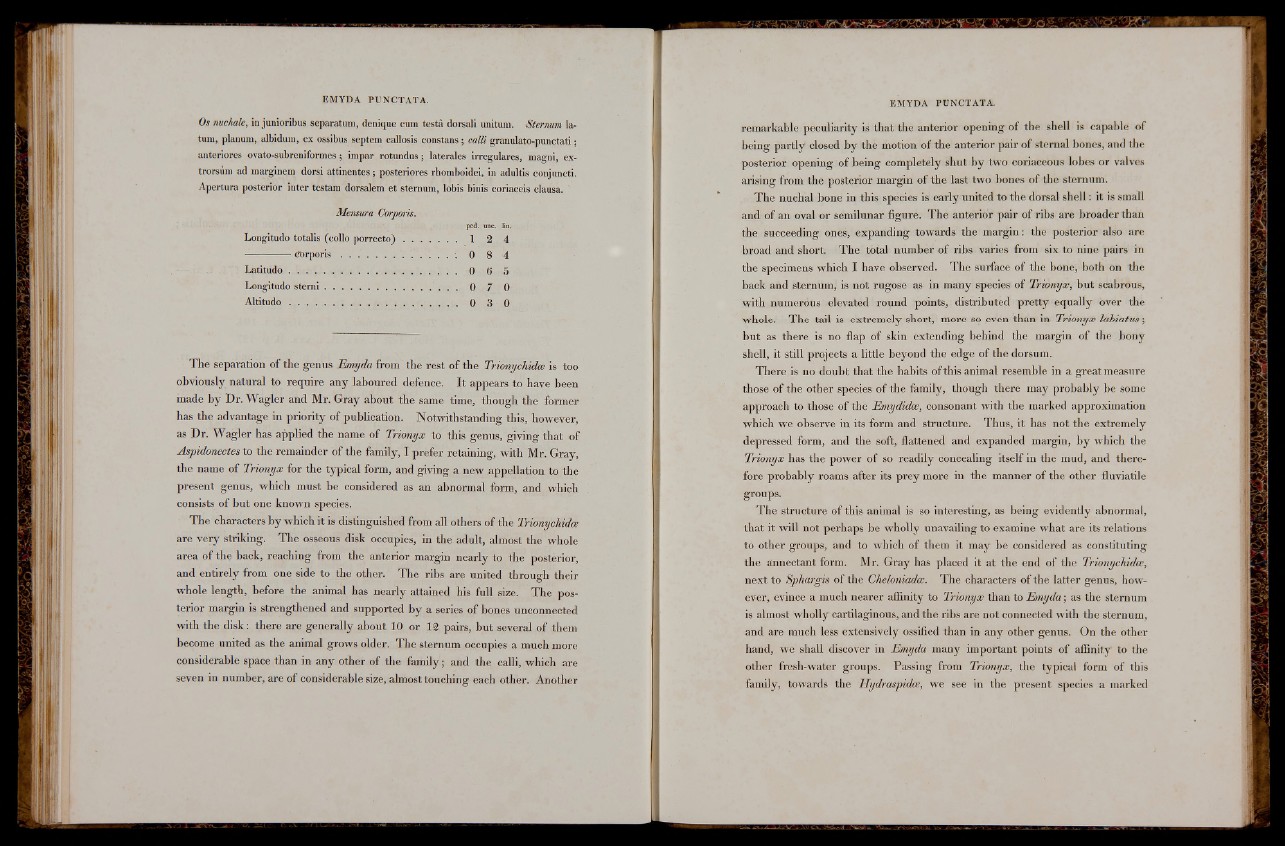
EMYDA PUNCTATA.
Os mollale, in junioribus separatum, denique cum testa dorsali unitum. Sternum, latum,
planum, albidum, ex ossibus septem callosis constans ; calli granulato-punctati ;
anteriores ovato-subreniformes ; impar rotundus ; laterales irregulares, magni, ex-
trorsùm ad marginem dorsi attinentes ; posteriores rhomboidei, in adultis conjuncti.
Apertura posterior inter testam dorsalem et sternum, lobis binis coriaceis clausa. '
Mensura Corporis.
ped. unc. lin.
Longitudo totalis (collo p o r r e c to ) 1 2 4
--------------COrporis.......................... 0 8 4
Latitudo ..................................................... 0 6 5
Longitudo s te rn i............................................. 0 7 0
A ltitu d o .................................................................... 0 3 0
The separation of the genus Emyda from the rest of the Trionychidce is too
obviously natural to require any laboured defence. It appears to have been
made by Dr. Wagler and Mr. Gray about the same time, though the former
has the advantage in priority of publication. Notwithstanding this, however,
as Dr. Wagler has applied the name of Trionyx to this genus, giving that of
Aspidonectes to the remainder of the family, I prefer retaining, with Mr. Gray,
the name of Trionyx for the typical form, and giving a new appellation to the
present genus, which must be considered as an abnormal form, and which
consists of but one known species.
The characters by which it is distinguished from all others of the Trionychidce
are very striking. The osseous disk occupies, in the adult, almost the whole
area of the back, reaching from the anterior margin nearly to the posterior,
and entirely from one side to the other. The ribs are united through their
whole length, before the animal has nearly attained his full size. The posterior
margin is strengthened and supported by a series of bones unconnected
with the disk: there are generally about 10 or 12 pairs, but several of them
become united as the animal grows older. The sternum occupies a much more
considerable space than in any other of the family; and the calli, which are
seven in number, are of considerable size, almost touching each other. Another
EMYDA PUNCTATA.
remarkable peculiarity is that the anterior opening of the shell is capable of
being partly closed by the motion of the anterior pair of sternal bones, and the
posterior opening of being completely shut by two coriaceous lobes or valves
arising from the posterior margin of the last two bones of the sternum.
The nuchal bone in this species is early united to the dorsal shell: it is small
and of an oval or semilunar figure. The anterior pair of ribs are broader than
the succeeding ones, expanding towards the margin: the posterior also are
broad and short. The total number of ribs varies from six to nine pairs in
the specimens which I have observed. The surface of the bone, both on the
back and sternum, is not rugose as in many species of Trionyx, but scabrous,
with numerous elevated round points, distributed pretty equally over the
whole. The tail is extremely short, more so even than in Trionyx labiatus;
but as there is no flap of skin extending behind the margin of the bony
shell, it still projects a little beyond the edge of the dorsum.
There is no doubt that the habits of this animal resemble in a great measure
those of the other species of the family, though there may probably be some
approach to those of the Emydidce, consonant with the marked approximation
which we observe in its form and structure. Thus, it has not the extremely
depressed form, and the soft, flattened and expanded margin, by which the
Trionyx has the power of so readily concealing itself in the mud, and therefore
probably roams after its prey more in the manner of the other fluviatile
groups.
The structure of this animal is so interesting, as being evidently abnormal,
that it will not perhaps be wholly unavailing to examine what are its relations
to other groups, and to which of them it may be considered as constituting
the annectant form. Mr. Gray has placed it at the end of the Trionychidce,
next to Sphargis of the Cheloniadce. The characters of the latter genus, however,
evince a much nearer affinity to Trionyx than to Emyda; as the sternum
is almost wholly cartilaginous, and the ribs are not connected with the sternum,
and are much less extensively ossified than in any other genus. On the other
hand, we shall discover in Emyda many important points of affinity to the
other fresh-water groups. Passing from Trionyx, the typical form of this
family, towards the Hydraspidce, we see in the present species a marked